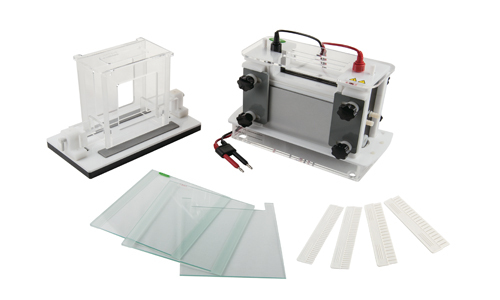Electrophoresis is a technique that is widely used for the separation and analysis of proteins, nucleic acids and other biological molecules, it is defined as the process of movement of a biological solution through an absorbent material due to an electric field.
It helps to isolate and separate different types of biological molecules according to their sizes and properties; from the results of electrophoresis, scientists can identify, quantify and compare chemical substances.
In general, electrophoresis is done through four main steps: sample preparation, initial gel work-up, electrophoretic system preparation and electrophoretic analysis
In sample preparation, scientists sometimes choose to separate or dissolve the sample in a saline solution, dilute the samples in a gel in sodium polyacrylate when using gel electrophoresis, and add collectors, such as bromopyridine, to help separate protein-containing samples.
Next, the sodium polyacrylate gel is started with a flavor, a dialysis membrane, and a feed cell, these steps help determine the concentration of the sample solution and the ionic concentration.
The initial gel run is executed as the second step to perform a successful sample analysis
In the initial gel work-up step, scientists add the electrophoretic solution, commonly a triethylammonium chloride solution, to the feed cell along with the sample, the ions present in the solution, along with the additional energy provided by the voltage, drive the movement of molecules through the gel.
The amount of movement by a molecule depends on several factors, including size and charge, when the sample solution and electrophoretic solution are brought together, an electric field is generated and the distribution of ions through the gel is responsible for moving the sample; the concentrations of the ions are important for the electric field to function properly.
Specialists should use a potentiometer for accurate and efficient results of their investigations
Therefore, the preparation step of the electrophoretic system is essential for the success of electrophoresis; in this step, the scientist must carefully control the concentration of the ions in the solution, the concentrations are measured using a potentiometer.
After setting the optimal processing limits, an electrical strap is connected to the sample to ensure the electrical energy needed for proper sample movement; the electrophoretic analysis part is the last stage of the electrophoresis process where the results are observed on a grid to determine the amount and composition of the sample.
Scientists can make observations and comparisons of any changes in the sample composition or in the sample itself
Visualization can be done in various ways, such as, for example, with an electron microscope or UV light, which determines the behavior of the sample under ultraviolet light, using these techniques, it is possible to see the relative position and size of the components within the sample and obtain valuable information for analysis.
In conclusion, electrophoresis is a simple technique that is widely used to separate and analyze biological molecules; it provides fast and quantifiable results that scientists can use to identify, quantify and compare chemicals.
Where scientists can purchase good quality electrophoresis to perform their analysis on biological samples
In Kalstein as a MANUFACTURER company you will be able to acquire the best ones, that is why we invite you to visit our website HERE to enjoy great offers and unbeatable prices, since we are MANUFACTURERS and we can guarantee your effective purchase.
In the link below you can choose one of the best electrophoresis manufactured in the market HERE

